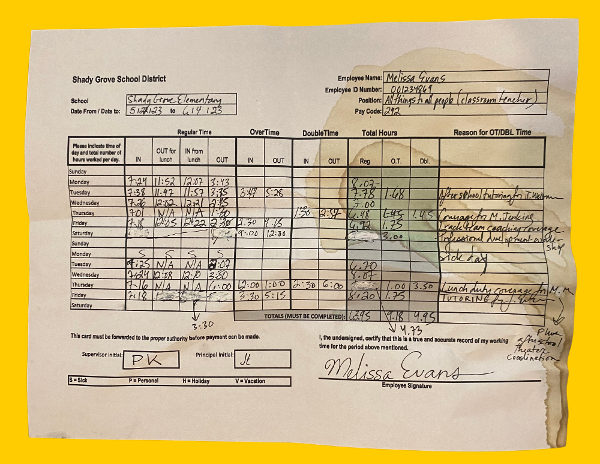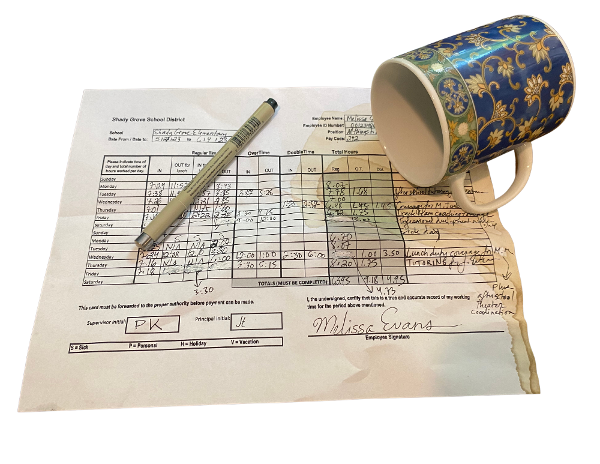- Products
-
About
- Resources
- Contact Us
- Products
- About
- Resources
- Contact Us
- Log In
- Get Started
May 25, 2023 • Insights

Banish antiquated, flawed timekeeping systems to the dusty old archives of history. It’s time to go digital.
Once upon a time, there was a Timesheet. Early one Monday morning, it was printed out with 1,199 of its companions on crisp, new paper. Each lucky timesheet would be handed to an employee in the school district: teachers, nurses, tech coordinators, bus drivers, and more!
“Two and a half reams of paper in total!” thought the Timesheet proudly. “And we used quite a bit of ink, too!”
The Timesheet was distributed to Ms. Evans, a fifth-grade teacher, who promptly stuffed it into her book bag as she set off to class. Evans was feeling a bit harried that week, as she needed to work overtime to cover for another teacher who was absent. So the lonely Timesheet was forgotten until Friday, when Evans suddenly remembered that she needed to fill in her hours.
As she took her pen and attempted to document her time within the teensy, tiny squares on the Timesheet, Evans mused aloud: “I can’t quite recall how many hours I worked on Monday or Tuesday…oh, I wish I’d written them down! And why are we still using these paper records? There must be a better way!”
“But this is how it has always been done!” thought the Timesheet. “As for your hours, just make your best guess! Accuracy has never been my specialty, after all.”
After using a quantity of white-out to correct her errors, Evans managed to elbow a full cup of coffee onto the unhappy Timesheet.
The Timesheet (now rather bedraggled, stained, and covered in barely-legible handwriting) was signed by Ms. Evans’ supervisor and delivered to the office staff, along with its 1,199 companions. Mr. Jones, weary after a busy week, began to manually enter the Timesheet’s data into a computer system.
I can barely read this. Is that a 7 or a 9?” cried Jones aloud, unwittingly entering the incorrect number (a mistake that would lead to a grievous payroll error, which would take hours to sort out). “Why are we still using these things? There must be a better way!”
“But this is the way it has always been done!” thought the Timesheet mournfully. “Think of the dreadful things that might happen if we were to change the process! How terrible! How frightening.”
Jones gnashed his teeth, flinging the Timesheet into a pile marked “Done.”
“Only 884 more to enter,” he said, picking up the next sheet in the pile and squinting. He had a powerful headache.
The Timesheet’s work was finally complete. It was packed into a box of records and trundled down to a storage room, where it would sit for the two years required by law.
As week after week passed, more and more timesheets were boxed and stored, joining the Timesheet as it gathered dust. But the Timesheet continued to repeat its proud mantra: “It’s just the way it’s always been done!”

As this little tale demonstrates, “it’s the way things have always been done” isn’t really a good rationale for treading the same path over and over again. It is, however, a common one. Fear of the unknown can make us cling to old ways—even when a process is fundamentally flawed.
Although our protagonist would protest, there are a number of clear reasons why paper timesheets are problematic—and why a digital solution is a smarter, more efficient way to go.
Here are a few examples.
We’re talking reams of paper and gallons of ink. Depending on the size of your district and how many copies need to be made, printing all these timesheets is both wasteful and costly. Requiring employees like Ms. Evans to manually record her time is distracting—teachers have more important tasks to do. Asking office staff to then input the time into a database is a further waste of time and human energy; you’re adding busywork atop busywork. By going digital, you’ll save time-consuming steps in the process.
Errors are prone to happen, no matter how careful employees are. Think about Mr. Jones attempting to decipher Ms. Evans’ scribbled handwriting, leading to a costly payroll error. When you add split shifts, overtime, “extra duty” pay, holiday pay, and other factors into the mix, a timesheet becomes even more complicated for both writer and reader. A digital solution can automatically adjust for multiple variables and do the math for you.
The reality is, the average employee won’t be vigilant about recording every hour worked in the moment, but will attempt to reconstruct their hours from memory after the fact. This method is notoriously suspect: According to Ebbinghouse’s Forgetting Curve, which “demonstrates the declining rate at which information is lost if no particular effort is made to remember it,” about 75 percent of what we learn usually fades away after a day or two. When employees clock in and out digitally, they won’t have to wrack their brains trying to recall a lunch break they took three days prior.
Paper timesheets can be easily misplaced, damaged, or destroyed. One coffee spill can easily wipe out a week’s worth of meticulous record-keeping. Now, reconstructing those hours from memory becomes even more of a challenge. Digital timekeeping, with backup systems in place, ensures that important data won’t go missing.
Our heroic Timesheet would gasp in horror, but tracking hours on paper opens the door for any unscrupulous employees to doctor their hours. Disgruntled staff members might feel as if their salary needs a little extra padding, and can easily “round up” hours in their favor or mark down personal time as hours worked. Other schemes that are easier to get away with on paper include “ghost employees”—someone using a false identity (such as that of a deceased person) to collect a salary. Read more about timesheet fraud.
According to the Fair Labor Standards Act (FLSA), “records on which wage computations are based should be retained for two years”—including time cards and work and time schedules. All those timesheets need to be boxed up and kept in a safe and secure place, especially if they contain personally identifiable information. And if those records aren’t filed and labeled correctly, Mr. Jones is going to be even more displeased when he has to dig into old paperwork to verify any data or correct any errors. Digital record-keeping saves space and makes it much easier to sort and search data.
In sum, it’s likely time to bid a fond farewell to our old friend, the paper Timesheet, and send it packing. (N.B. Unfortunately, you’ll still have to keep it in storage for two more years.)
Red Rover’s time tracking solution is built exclusively for K-12 school districts and can help you escape the costly, time-consuming, and error-prone process of paper timesheets. Schedule a demo for a firsthand look!
Subscribe to get the latest Red Rover news and insights delivered straight to your inbox.
Red Rover builds best-in-class software solutions for mission-critical tasks in K-12 human capital management. Join 1,500+ school districts in the Red Rover revolution today.
We send occasional emails jam-packed with strategies, events, and insights delivered straight to your inbox!